A University of Cordoba and Spanish National Research Council research team validated an indicator based on using a tree's temperature to calculate relative water consumption at an almond tree plantation
In 1995, the severe drought that devastated Spain left some farms using irrigation agriculture without water supplies. Though it has not happened again since, climate change increases the chance of this threat. For farmers growing annual crops, an occurrence such as this one would mean losing a year's work but those who have groves of trees risk losing not only their year's production, but their long-term investment as well.
A research team from the University of Cordoba and the Institute for Sustainable Agriculture at the Spanish National Research Council in Cordoba has been working for years on several projects to improve water management and maximize the productivity of tree crops such as olives, almonds and citrus fruits. One of their lines of research is based on the fact that when there is a water shortage, trees transpire less, get warmer, and end up producing less.
In their latest research project, they studied how an indicator called Crop Water Stress Index (abbreviated to CWSI), based on detecting temperature increase in trees with water stress, is related to relative water consumption in an almond grove. Tree water consumption or transpiration is very difficult to measure whereas a tree's temperature is easily taken using remote sensors, similar to those used on a daily basis during the pandemic to detect people with fevers. In their latest work, this group experimentally demonstrated for the first time that there is a relationship between relative transpiration and the CWSI in almond trees. So, farmers can find out at any moment if the trees are consuming water at 80-90% of their capacity, meaning within optimal levels, or if they have high levels of stress and urgently need to be supplied with more water.
"This indicator, the CWSI, has the advantage that relative water consumption can be determined via remote sensing, using drones or manned planes and a map of the transpiration in different areas of a plantation can be obtained. In the future, satellites will most likely be used to do this work very precisely on big plantations", explains Elías Fereres, Professor Emeritus of the Agronomy Department at the University of Cordoba and a member of the research team, which is led by Victoria González Dugo from the Institute for Sustainable Agriculture at the Spanish National Research Council.
Therefore, these CWSI maps will allow for irrigating different areas of a farm in different ways in terms of the water level needed at each moment, thus maximizing production with the minimal necessary water resources or those available at the time. This research is within the framework of the technique known as precision irrigation, a new system that uses the most advanced technology to irrigate at an optimal level, supplying the exact amount of water to every part of the grove and circumventing losses. "The aim is to use water effectively and where it is most needed", points out Elías Fereres.
Though the research was performed on almond plantations, this research could be used on other tree crops such as olive trees, which are so important to the economy in Andalusia and on many occasions suffer from times of water shortages.
A related project on which the group is also working is being led by Professor Francisco Villalobos from the University of Cordoba. It is called Project Olive-Miracle, which aims to develop a model to forecast how olive trees behave to climate change, which would provide more information in order to make decisions in the sector in the future.
V. Gonzalez-Dugo, L. Testi, F.J. Villalobos, A. López-Bernal, F. Orgaz, P.J. Zarco-Tejada y E. Fereres. "Empirical validation of the relationship between the crop water stress index and relative transpiration in almond trees". Agricultural and Forest Meteorology
DOI: https://doi.org/10.1016/j.agrformet.2020.108128
A is for Almond but also for Avocado
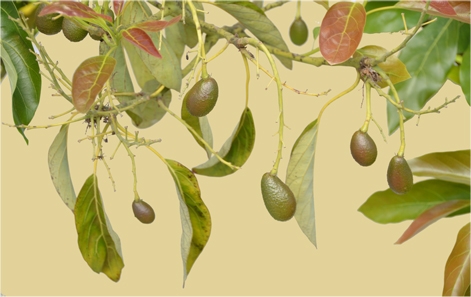
avocados on a tree picture
Posted on
Friday, November 6, 2020 at
8:19 AM
Focus Area Tags: Agriculture
Maintenance of Microirrigation Systems
Here's where to look to solve those system problems and resolve them
http://micromaintain.ucanr.edu/Solutions/know/
Microirrigation systems include microsprinklers for tree crops, drip emitters for trees, vines, and some row crops, and drip tape for row and field crops. Microirrigation systems apply water to the soil through emitters that are installed along drip lines and contain very small flow passages. Microirrigation systems can apply water and fertilizers more uniformly than other irrigation methods. This uniformity results in potentially higher yields, higher revenue, and reduced irrigation operating costs.
Uniformity, a performance characteristic of irrigation systems, is a measure of the evenness of the applied water throughout the irrigation system. Distribution uniformity (DU), sometimes called emission uniformity (EU), is an index that describes how evenly or uniformly water is applied throughout the field. A uniformity of 100% means the same amount of water was applied everywhere. Unfortunately, all irrigation systems apply water at a uniformity of less than 100%, and thus some parts of a field receive more water than others. Field evaluations have shown that microirrigation systems have the potential for higher uniformity than other irrigation methods. However, clogging reduces the uniformity of applied water in microirrigation systems, thus increasing the relative differences in applied water throughout a field.
The small flow passages in the emitters and microsprinklers make microirrigation systems highly susceptible to clogging. Clogging reduces the uniformity of the applied water and decreases the amount of applied water. Clogging also decreases the amount of salt leaching around the lateral line in saline soils.
The objective of this web site is to provide information to irrigators about the causes of clogging and the methods for preventing or correcting clogging problems in microirrigation systems. Among the topics covered are the sources of clogging, chlorination, preventing chemical precipitation, filtration, flushing, and monitoring microirrigation systems.
This web site is divided into sections to allow the users to more quickly access the information they want. For example, if you already know you have a clogging problem and you want to solve it, go to the section Solutions to Existing Clogging Problems - "I have a problem and I want to solve it".
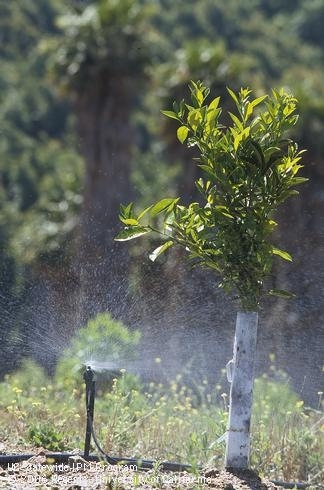
irrigATING CITRUS
Posted on
Wednesday, September 30, 2020 at
9:05 AM
Focus Area Tags: Agriculture
Thanks for the rains that leach the soils of accumulated salts and bring on new fresh growth. Or maybe not. When we apply irrigation water with salts which with few exceptions we do in irrigated agriculture, salts accumulate in the soil. They accumulate in a certain pattern depending on the type of irrigation and soil type. There's a strong tendency for drip and microsprinklers to form a pattern of salt accumulation near the margins of the wetted patterns. This pattern is stronger with drip because the source point is always pushing a front outward from the emission point. This pattern occurs with microsprinklers, as well, although not as strongly. These patterns continue to form and accumulate as long as there is no rainfall to evenly push the salt down below the root zone. The longer the period of no rain, the larger the salt concentration at the margin.
So the way water moves is generally down. It moves in a wetting front drawn by gravity. It moves laterally too, because of the attraction water has for the soil particles. It will move laterally more in a clay soil than in a sandy soil because there are more particles in a clay soil than a sand (actually more surfaces that hold water). It also carries salt with it. Wherever the water moves, the salt moves. The more rain, the more salt is moved down. The more rain, the deeper the salt is pushed.
The problem with rain, is that if there is not enough, the salt tends to move laterally. In this wet soil solution, the salt is moving from where it is concentrated, to where there is a lower one. And if there isn't enough rain to move that salt down, it just moves back along the salt gradient, back to where the water first came from…….towards the roots. And that salt may be at such a high concentration that it can cause plant damage.
We talk about effective rainfall. This is usually about a quarter of an inch of rain. This is the amount of water to do more than just wet the dust, it's the amount to move water into the root zone. It is also moving salts into the root zone which can be a real problem. A good rain will do more than wet the dust, it will also move the salts out of harm's way in the root zone. The amount of rain necessary to do this is going to depend on the salt accumulated and the soil texture. The more salt, the more rain needed. The finer the texture, the more rain.
So there is no good cookbook, other than you need enough. And the first rains of the year, watch out. This is often when there is the highest salt accumulation and in the fall when we have the most irregular rains. Small rain amounts that can move salt into the root zone. A rule of thumb is a minimum of a good one inch rain event or combined rain events of two inches in a short period is needed to dissolve and move the salts out of the avocado root zone's top 18 inches. The more the better.
If there is not enough rain……………The solution !!!!!!!! Run the irrigation system to make sure there is enough to move that salt down.
Get ready to irrigate with the first rains if they are insufficient for adequate leaching.
Also get ready for the first smell of rain - petrichor.
Petrichor (/'p?tr?k??r/) is the earthy scent produced when rain falls on dry soil. The word is constructed from Greek petra (π?τρα), meaning "stone", and ichor (?χ?ρ), the fluid that flows in the veins of the gods in Greek mythology.
The term was coined in 1964 by two Australian CSIRO researchers, Isabel Joy Bear and Richard G. Thomas, for an article in the journal Nature.[1][2] In the article, the authors describe how the smell derives from an oil exuded by certain plants during dry periods, whereupon it is absorbed by clay-based soils and rocks. During rain, the oil is released into the air along with another compound, geosmin, a metabolic by-product of certain actinobacteria, which is emitted by wet soil, producing the distinctive scent; ozone may also be present if there is lightning.[3] In a follow-up paper, Bear and Thomas (1965) showed that the oil retards seed germination and early plant growth.[4]
In 2015, scientists from the Massachusetts Institute of Technology (MIT) used high-speed cameras to record how the scent moves into the air.[5] The tests involved approximately 600 experiments on 28 different surfaces, including engineered materials and soil samples.[6] When a raindrop lands on a porous surface, air from the pores forms small bubbles, which float to the surface and release aerosols.[5] Such aerosols carry the scent, as well as bacteria and viruses from the soil.[5] Raindrops that move at a slower rate tend to produce more aerosols; this serves as an explanation for why the petrichor is more common after light rains.[5]
The human nose is extremely sensitive to geosmin and is able to detect it at concentrations as low as 5 parts per trillion.[7] Some scientists believe that humans appreciate the rain scent because ancestors may have relied on rainy weather for survival.
https://en.wikipedia.org/wiki/Petrichor
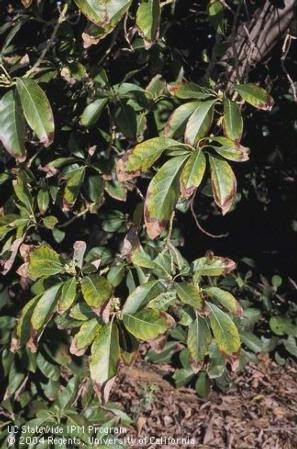
avocado salt damage
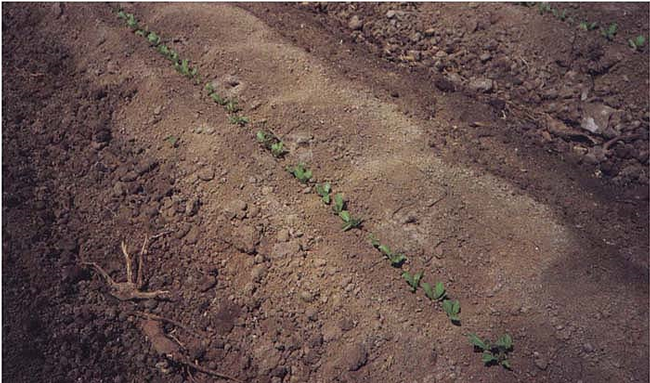
salt pattern
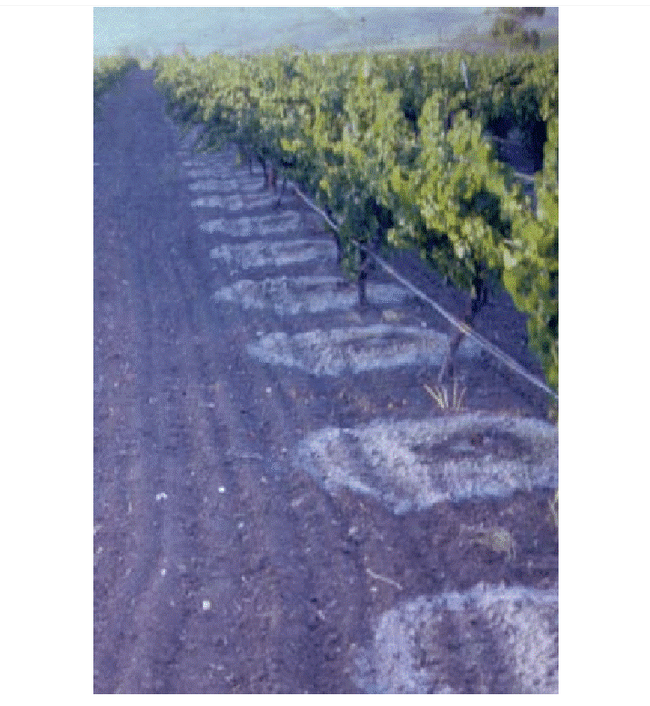
salt rings
Posted on
Friday, November 16, 2018 at
7:00 AM






